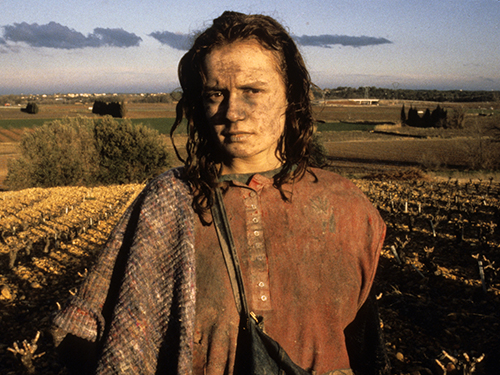
A young woman's body is found frozen in a ditch. Through flashbacks and interviews, we see the events that led to her inevitable death.
“No one claimed the body. She had died a natural death without leaving a trace. But people she had met recently remembered her. Those witnesses helped me tell of the last weeks of her last winter. She left her mark on them. I know little about her myself, but it seems to me that she came from the sea.”
Agnès Varda1
“Varda’s vagabond is, fittingly, a traveller who turns the image field she crosses into a mobile writing, a wanderer who produces a ‘motion’ picture, a figure for whom errancy and venture are a scriptural activity. The landscape she traverses is recognizably France of the 1980s: the Midi over-planted with vineyards; country houses and resorts uninhabited during winter; burglaries at epidemic stage and the omnipresent yapping guard dogs; the train-station traînés, paumés, and punks, all of France’s marginalia – chief among whom are the migrant workers from the Maghreb, the labourers in the vineyards. But if the passage of Mona, the nomad, situates events in the here-and-now, much of the film pulls us back to the archaic, to figures that have long populated the psyche and found expression in the plastic arts of the oldest civilizations – since paint was first applied to pottery and statuary. The Mona lifted frozen, petrified, from a ditch is unearthed like a statue by archaeologists who then measure the site, while police photographers murmur, ‘Le visage, prenez le visage.’ The film begins with a lengthy tracking shot towards a prehistoric tumulus marking the place of her death.”
Florianne Wild2
“Watching her from a distance, the camera often catches her in sweeping glances. Frequently the camera is already tracking across a landscape when Mona enters, striding along a highway or across a barren field, and it continues moving after she’s left the frame, almost as if to express the elusiveness of any project that attempts to know someone from the outside.
Varda also aligns Mona with the French landscape. The film was shot in Southern France near Nimes, the place where Varda grew up and that she dubs the ‘wild South’. Speaking with critic Annette Insdorf in The New York Times in 1986, Varda said, ‘I’m tired of the fact that French films never have space, as if the entire universe of the French cinema were psychological, internal and enclosed’. Varda opts for the external, going so far as to prevent us from gleaning Mona’s motivations, leaving us to judge her as we will.
The film’s original title, Sans toit ni loi, offers further insight; translated more accurately, the title means ‘Without a Roof or Law’ or ‘Homeless and Lawless’, both of which point to the fact that Mona refuses the basic aspects of contemporary social structures. In many ways, Mona shares more with the innumerable barking dogs that populate the film, refusing to play by the social mores that dictate that citizens be useful. Mona is instead driven by some internal negativity that perhaps has something in common with Georges Bataille’s notion of dépense, or the useless expenditure of energy that cannot be reabsorbed into an economy in a manner that is useful. Mona refuses to be predictable, much less productive; she eschews everything given to her, instead drifting along aimlessly.”
Holly Willis3
“The tracking shots emphasise Mona’s movements, yet far from confirming her freedom, they often highlight her isolation and signal all the social spaces that she cannot access because of her status of outsider. Mona is often seen walking along high walls, deserted roads, past closed gates. She also walks from right to left on the screen, which goes against the normal film reading habits of Western audiences, from left to right. […] The tracking shots are also less focused on Mona than it may initially seem: frequently, the camera is already tracking across a landscape when Mona moves into the frame and the shot continues moving after she has left the frame. […] On several occasions, Mona leaves the frame for a few seconds before reappearing. This filming strategy illustrates how difficult it is to keep the elusive Mona within the frame of the camera. She embodies marginality and cannot be contained within the frameworks set by society – or film directors.”
Isabelle Vanderschelden4
“De eigennaam van het personage, Mona, doet onwillekeurig denken aan wat Leibniz aangeeft als de monadologie en Deleuzes omkering ervan in zijn concept van de nomadologie. In het monadisch denksysteem is ieder deel van het geheel verbonden door een algemeen beginsel. Voor Leibniz is een monade iets of iemand dat/die opereert binnen de gesloten eenheid van een universum. In navolging van Deleuze koppelde Braidotti Leibniz’ monadologie aan het representatieve denken en het normatieve rationaliteitsbeginsel waarbij één enkel vast referentiepunt het centrerende principe uitmaakt. Verschillen in de waarneming zijn daarbij enkel het gevolg van een verschillende helderheidsgraad van de waarneming, maar in principe ziet iedereen volgens de monadologie hetzelfde: ‘Like puppets manipulated by their master, in Leibniz’s thought, each “window” open onto the unlimited universe of being is circumscribed by its own position in this universe.’”
Christel Stalpaert5
- 1Agnes Varda in the voice-over of the opening scene.
- 2Florianne Wild, “Ecriture and Cinematic Practice in Agnès Varda’s Sans toit ni loi,” The Film & the Book, Vol. 30, No. 2, Summer 1990, 92.
- 3Holly Willis, “Vagabond,” Senses of Cinema, April 2004.
- 4Isabelle Vanderschelden, Studying French Cinema (New York: Columbia University Press, Auteur Publishing, 2013), 103.
- 5Christel Stalpaert, “Intersubjectief wandelen met het landschap: nomadisch denken in Agnès Varda's Sans toit ni loi (1985) en Chantal Akermans Les rendez-vous d'Anna (1978),” in Johan Swinnen (ed.), Anders zichtbaar. Zingeving en humanisering in de beeldcultuur (Brussel: VUBPress, 2010), 121-134.

